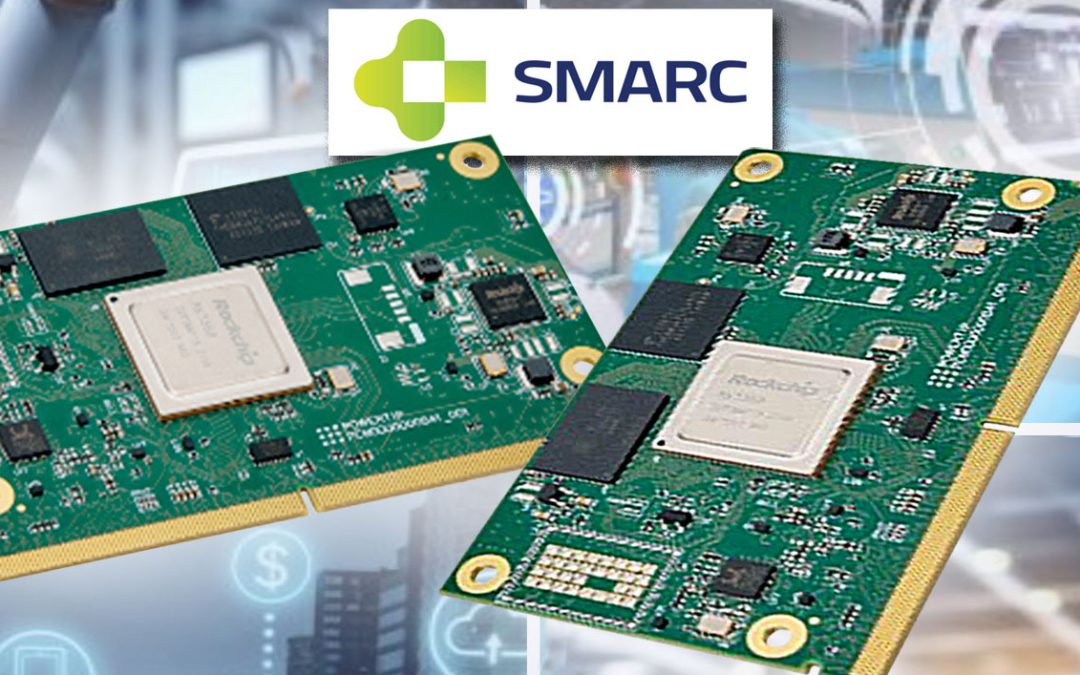The terms Computer on Module (COM) and System on Module (SOM) are often used interchangeably, but there are subtle differences.
Computer on Module (COM)
A COM typically includes a processor, memory, and essential peripherals on a single board. The primary function is to provide computing power and it often requires a carrier board for I/O and additional connectivity.
System on Module (SOM)
A SOM is like a COM but typically includes more integrated components to form a more complete system. Typical components include: processor, memory, storage and I/O interfaces, plus integrated peripherals such as numerics and graphics processing.
Key differences between COMs and SOMs
COMs focus on providing core computing capabilities, while SOMs are designed to be closer to complete systems with more integrated peripherals. SOMs are more self-contained and are preferred for applications needing a compact, integrated solution.
The SMARC Standard
SMARC (Smart Mobility ARChitecture) is a standard designed to provide a standardised form factor and interface for embedded computing applications. Developed by the Standardisation Group for Embedded Technologies (SGET).
SMARC modules come in two standard sizes: 82 mm x 50 mm and 82 mm x 80 mm. Designed for low-power applications, SMARC modules typically consume between 2 and 6 watts. A wide range of interfaces are supported, including: displays, cameras, connectivity, storage, peripherals s and audio.
When to choose a COM
If the project requires a highly-customised carrier board to meet specific I/O requirements, a COM is the best solution. The carrier board can be designed to include only the necessary interfaces and peripherals. COMs offer flexibility for a range of applications, allowing the same module to be used with different carrier boards for different projects.
For large-scale production, designing a custom carrier board can be more cost-effective than purchasing more integrated SOMs, especially when only the core computing power is required.
COMs allow for easier upgrades of the core computing module without changing the carrier board, providing a path for future performance improvements.
When to choose a SOM
SOMs integrate more components and peripherals on the module itself, providing a near-complete system that requires minimal additional hardware. This is ideal for applications needing compact, self-contained solutions. This can significantly reduce development time and effort, allowing for quicker deployment of products.
For compact, low-power applications, SOMs are suitable for portable and battery-powered devices where space and power efficiency are critical.
SOMs simplify the development process by providing a more complete hardware solution, which can be an advantage for teams with limited expertise in hardware design.
A typical SMARC SOM
The new SMARC System-on-Module from Inelco Hunter is a powerful, ultra-small SOM designed for applications demanding compactness and energy efficiency.
This innovative SOM uses the SMARC standard, making it ideal for mobile devices, fleet management, factory automation, medical equipment, portable devices, and industrial IoT applications.
The new Inelco Hunter module integrates core SOM functions, including SDRAM and Flash memory, within a standardised footprint of 82mm x 50mm. At its core is the robust RK3568 Quad-Core ARM Cortex-A55 CPU, delivering exceptional performance.
Integrated peripherals include numeric and graphics processing. The graphics GPU is a Mali-G52-2EE, supporting OpenGL ES 1.1/2.0/3.2, OpenCL 2.0, and Vulkan 1.1, whilst the NPU RKNN Accelerator provides remarkable processing power, up to 1 TOPS. Memory configuration includes onboard SDRAM and eMMC Flash.
Supporting up to three displays, the Inelco Hunter module offers a very wide range of I/O options. The SOM module supports industry-standard operating systems, including Linux (Buildroot, Yocto, Debian) and Android OS.
Conclusions: COM, SOM and SMARC
Ultimately, the decision will depend on the specific requirements of the project, including the desired level of integration, development timeline, budget, and the need for customisation versus a ready-to-use solution.
Inelco Hunter will assist in the decision-making process by offering comprehensive engineering and software support. This added-value support is a cornerstone of Inelco Hunter’s philosophy and has been over the past 30 years.
Direct link to Inelco Hunter SMARC page:
http://www.inelcohunter.co.uk/smarc

